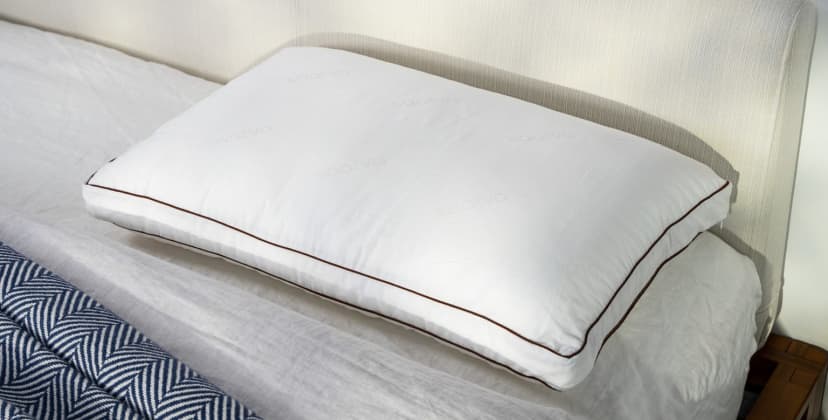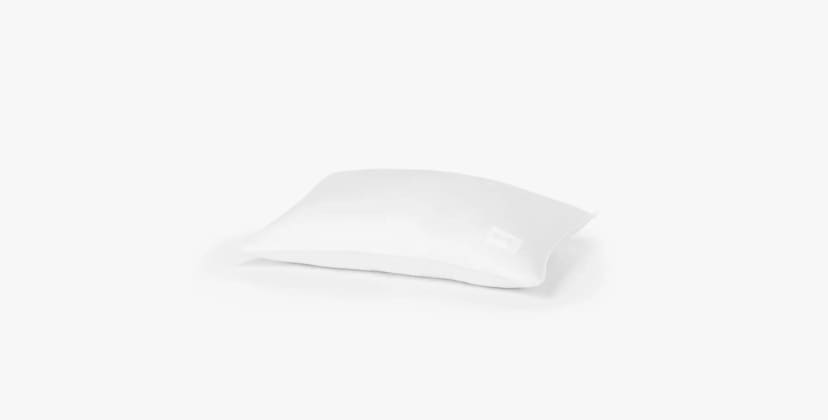When you buy through our links, we may earn a commission. Products or services may be offered by an affiliated entity. Learn more.
If you experience allergies, your pillow choice can affect your symptoms. The best pillows for allergies contain materials that are resistant to dust mites, mold, mildew, and other allergens. These include core materials such as memory foam and latex and cover materials like natural cotton, bamboo-derived textiles, and Tencel.
Pillows in particular can attract dust mites and other allergens that cause sneezing, congestion, or itchiness. A pillow made from natural, hypoallergenic materials can be a good investment if your allergies make it difficult to sleep. The best pillows for allergies typically contain latex, down alternative fibers, silk, and other fills that resist dust mites and mildew. You can also invest in a pillow with a cover made of moisture-wicking fabrics, such as organic cotton, Tencel, and rayon derived from bamboo.
We’ll discuss which pillows are best for people with allergies and provide tips for keeping allergens out of your sleep space. We’ll also provide detailed information about each pillow’s design and how they performed during our hands-on tests so you can determine the best pillows for your needs.
The Best Pillows for Allergies
-
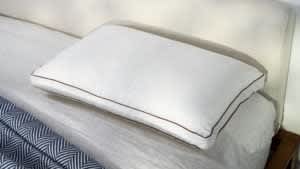
Best Overall
Saatva Latex Pillow
Shop Now
-
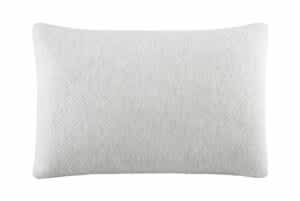
Most Comfortable
Brooklyn Bedding Talalay Latex Pillow
Shop Now
-
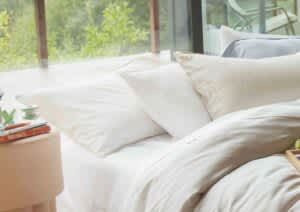
Best Value
Buffy Cloud Pillow
Shop Now
-
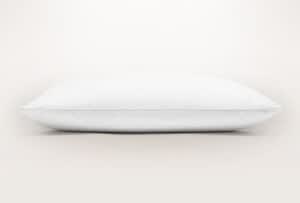
Best Luxury
Boll & Branch Down Alternative Pillow
Shop Now
-
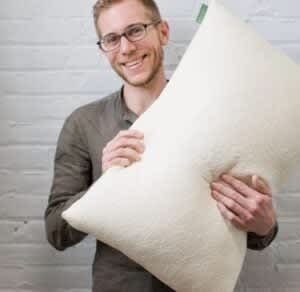
Best for Side Sleepers
Avocado Green Pillow
Shop Now
-
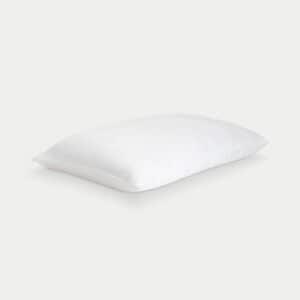
Best Temperature Regulating
Cozy Earth Silk Pillow
Shop Now
-

Softest
Sweet Zzz Plant-Based Pillow
Shop Now
In-Depth Reviews
The Saatva Latex Pillow has an exceptional balance of responsiveness and plushness that’s perfect for snuggling without sacrificing support. Our testers really enjoyed the gentle contouring in the head and neck.
-
Pros
-
Shredded latex core cushions the head and neck without compressing too deeply
-
Two loft options to accommodate different sleep positions
-
Breathable materials ensure consistent cooling and temperature control
-
-
Cons
-
Too soft for people who need a firm pillow with extra support
-
Sticker price may be too expensive for some shoppers
-
Price Range
$165 – $185
Fill
Shredded Talalay latex and down alternative
Firmness
Medium Soft
Why It’s Best Overall
Sleepers looking for a pillow that strikes an even balance of cushioning and support should find what they need in the Saatva Latex Pillow. This model is available in two lofts that cater to a wide array of sleep preferences and positions. While not suitable for sleepers with latex allergies, the pillow resists dust mites, mold, and other common allergens.
How It Performed
During tests, this pillow performed extremely well for back and side sleepers. The high-loft option measures 6 to 7 inches thick and fared better with side sleepers, who tend to enjoy thicker pillows to fill the space between their neck and the bed surface. The low-loft option is 4 to 5 inches thick and felt most comfortable to back sleepers, or side sleepers who prefer pillows with mid-range lofts. Both models provided plenty of cushioning to cradle the head and neck, while maintaining the support needed to keep the head aligned with the spine without straining the neck.
What It’s Made Of
The pillow is designed with two chambers. The outer chamber is filled with microdenier fibers that mimic the feel of down, while the inner chamber is composed of moldable shredded latex that promotes contouring. The cover is made of machine-washable cotton with a breathable quality that helps keep the pillow cool. The latex has natural cooling properties that further promote thermoregulation. Saatva recommends spot cleaning the pillow if stains occur. You can choose between a queen or king size.
Shipping is free of charge to addresses in the contiguous U.S. Saatva offers a 45-day sleep trial to test the pillow at home. The pillow is further backed by a one-year warranty.
Most Comfortable
Brooklyn Bedding Talalay Latex Pillow
Use this link for the most current discount.
Shop Now
The Brooklyn Bedding Talalay Latex Pillow checks the most important boxes for people with allergies. A latex core resistant to dust mites and a moisture-wicking cover that’s easy to wash helps reduce symptoms, making it easier for those with allergies to sleep through the night.
-
Pros
-
Cover composed of moisture-wicking Tencel fabric
-
Solid latex core is supportive, breathable, and long-lasting
-
Affordable pricing compared to competing models
-
-
Cons
-
Lacks moldability for people who enjoy snuggling with their pillow
-
Loft exchanges are not allowed during the trial period
-
Price Range
$89 – $99
Fill
Talalay latex
Firmness
Medium Firm
We enjoyed the Brooklyn Bedding Talalay Latex Pillow for its balance of cushioning and responsiveness. The latex core contours gently to the head and neck without too much hugging or sinkage, and two loft levels make the pillow equally suited to side and back sleepers. Our tests also showed the pillow excels at temperature control and shape retention.
How It Performed
Most of our testers found the Talalay Latex Pillow comfortable, though their preferences differed in terms of the best loft. Our side sleepers received ample cushioning from the 5-inch pillow, resulting in even alignment for the head, neck, and shoulders. Back sleepers preferred the 4-inch loft instead. Both lofts were too thick for stomach sleepers on our team, but the 4-inch pillow didn’t crane their necks as much as the 5-inch model.
Our heat guns and thermal imaging software revealed excellent temperature control for the Talalay Latex Pillow. A breathable cover combined with a ventilated latex core makes the pillow suitable for hot sleepers. Since the latex is solid, not shredded, the pillow also retains a full shape and doesn’t need to be fluffed.
What It’s Made Of
The pillow’s core is composed of solid, ventilated Talalay latex. This material has a springy, responsive feel and doesn’t contour as closely as memory foam or polyfoam. A cover made of Tencel encases the latex, adding softness to the surface. The cover is fully machine-washable, but sleepers should only spot clean the latex core with light dabbing if stains occur. You can choose from a 4- or 5-inch loft as well as queen and king sizes.
The Talalay Latex Pillow carries a below-average sticker price compared to other latex pillows, and Brooklyn Bedding offers free ground shipping to customers in the contiguous U.S. Your purchase includes a 30-night sleep trial. If you decide to keep the pillow, it’s also backed by a three-year warranty.
The Buffy Cloud Pillow lives up to its name thanks to its down alternative fill. You can choose from three firmness levels based on your sleep position and support needs, but each design provides excellent cushioning and cradling for the head and neck.
-
Pros
-
Tencel shell promotes excellent temperature control
-
Available in three firmness levels
-
Shoppers receive a discount for purchasing multiple pillows
-
-
Cons
-
Tencel shell promotes excellent temperature control
-
Pillow is available in three firmness levels
-
Shoppers receive a discount for purchasing multiple pillows
-
Price Range
$55 – $70
Fill
Recycled PET fibers
Firmness
Soft, Medium, Firm
Sleepers looking for a soft, plushy pillow should find the Buffy Cloud Pillow meets their needs. The fill consists of down alternative clusters that mimic the softness of real down without triggering allergies or retaining excess heat. Buffy offers a discount for shoppers who purchase more than one pillow, making it an excellent value for shoppers on a budget.
How It Performed
Among all three of the Cloud Pillow’s firmness levels, our side sleepers felt most comfortable on the firm pillow. This model offers the highest loft, ensuring plenty of cushioning between the head and shoulder to promote even alignment. Our back sleepers were torn, with some preferring the firmer pillow and others finding the medium model more suitable. Stomach sleepers found the soft pillow provided enough cushioning without straining their necks.
Tencel is known for excellent temperature control. Since the cover is composed of this material, we weren’t surprised to find the Cloud Pillow slept cool throughout our tests. The down alternative clusters also make the pillow highly moldable, though routine fluffing may be needed to maintain a full shape.
What It’s Made Of
The Cloud Pillow’s PET down alternative fill is derived from recycled plastic bottles — up to 30 bottles are used to produce a single pillow. A cover made of moisture-wicking Tencel encases the fill. The fabric is luxuriously smooth and chemical-free, so the pillow should be suitable for people with sensitive skin. Buffy recommends spot cleaning the pillow if stains occur and using a washable pillowcase to keep it hygienic.
Standard shipping is free to addresses in the contiguous U.S. Buffy allows you to test the pillow for a week before charging your credit card, and returns are accepted within 50 days.
Best Luxury
Boll & Branch Down Alternative Pillow
Use this link for the most current discount.
Shop Now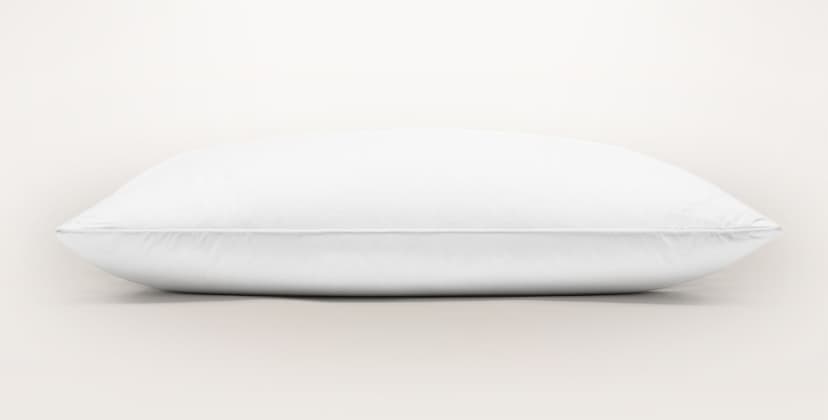
Boll & Branch’s Down Alternative Pillow provides the softness and loft of real down with an allergy- and animal-free design. Three firmness levels ensure most people will find the pillow comfortable regardless of their primary sleep position.
-
Pros
-
Down alternative clusters mimic the softness and lightness of authentic down
-
Shell composed of breathable organic cotton
-
Three firmness levels to accommodate different sleep positions
-
-
Cons
-
Expensive pricing compared to the average down alternative pillow
-
30-night trial is somewhat short
-
Price Range
$88 – $98
Fill
PrimaLoft synthetic microfibers
Firmness
Soft, Medium, Firm
The Boll & Branch Down Alternative Pillow is a great option for those who sleep on their side, back, or stomach and prefer animal-free products. The pillow is available in three unique firmness levels, each of which caters to a different sleep position. All pillows are wrapped in a breathable organic cotton shell, and the machine-washable design makes the pillow easy to keep clean and free of allergens.
How It Performed
Our team tested all three firmness levels of the Boll & Branch Down Alternative Pillow. For our side sleepers, the firm pillow provided enough cushioning to keep their heads and necks aloft. Some back sleepers also felt comfortable with this model, but most preferred the medium option because it propped up their heads without causing neck strain. Our stomach sleepers found that the low-loft soft pillow worked best for them.
Temperature control was a highlight during our tests. The fill retains minimal heat, and the breathable cover promotes plenty of airflow. You may need to fluff the pillow somewhat frequently, but the down alternative clusters make it moldable and great for snuggling.
What It’s Made Of
All three versions of the Down Alternative Pillow contain clusters of PrimaLoft, a down alternative material derived from polyester. The shell is composed of organic cotton. The pillow is machine-washable, though Boll & Branch notes you may need up to three drying cycles before it’s completely free of moisture. Dryer balls may help speed up the drying process.
The pillow is competitively priced, and you’ll receive a 5% discount if you bundle your purchase with other Boll & Branch bedding items. It’s worth noting that the three firmness options differ slightly in price. Standard ground shipping is free for domestic U.S. orders. Returns are permitted within 30 days of delivery as long as the pillow is in its original condition with tags intact.
Best for Side Sleepers
Avocado Green Pillow
Use this SleepFoundation.org link for the most current discount on Avocado pillows
Shop Now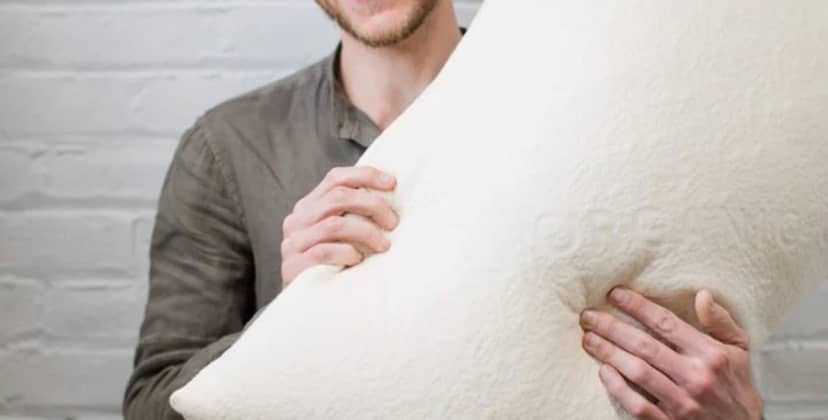
Thanks to its adjustable loft and moderate cushioning, the Avocado Green Pillow suits a wide range of sleepers across different body types and sleep positions. Adding to the supreme comfort of the pillow is its sustainable construction, as both the cover and fill have earned organic certifications.
-
Pros
-
Shredded latex and kapok fiber fill is springy and plush
-
Customizable design lets you adjust the loft and firmness
-
GOLS and GOTS certifications indicate sustainable sourcing
-
-
Cons
-
Not suitable for people who prefer deep contouring and cushioning
-
Sleepers may need a few nights to nail down their preferred fill volume
-
Price Range
$89 – $109
Fill
GOLS-certified shredded latex and GOTS-certified kapok fibers
Firmness
Medium
Your ideal pillow loft largely depends on your primary sleep position. With the Avocado Green Pillow, you can add or remove fill to make it feel fuller for side sleeping, flat for stomach sleeping, or something in between for back sleeping. The fill combines shredded latex and soft kapok fibers, resulting in gentle contouring and a bit of responsiveness.
How It Performed
The majority of our team members gave positive ratings to the Avocado Green Pillow, though their loft preferences differed. Our side sleepers felt most comfortable with all of the fill intact, with some adding additional fill included with each order. Back sleepers removed about 20% to 30% of the fill in order to achieve their ideal loft, while stomach sleepers needed to remove at least 50%.
Due to fill that retains minimal heat and a breathable cover, the pillow performed well during our temperature control tests. Other tests, such as shape retention and moldability, yielded variable results because these factors largely depend on how much fill you use.
What It’s Made Of
The fill consists of shredded latex blended with fibers from the kapok tree, which have a soft, lightweight consistency reminiscent of real down. Both the outer cover and inner fill pouch are composed of organic cotton. You can machine-wash the outer cover, but you’ll need to remove the fill pouch first. The latex holds certification with the Global Organic Latex Standard (GOLS), and the cotton and kapok fibers are certified by the Global Organic Textile Standard (GOTS).
Shoppers can opt for one pillow at checkout or purchase two and receive a small discount. Each pillow comes with an extra fill bag at no additional cost. Avocado sells fill bags separately if you ever need to replenish your supply. Shipping is free throughout the contiguous U.S. The Green Pillow is backed by a 100-night trial period and one-year manufacturer’s warranty.
Best Temperature Regulating
Cozy Earth Silk Pillow
Up to 25% off + free shipping for orders of $50 or more
Shop Now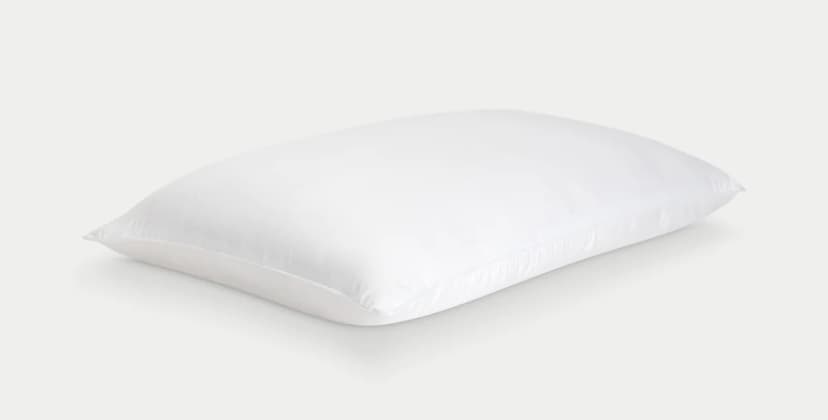
The Cozy Earth Silk Pillow showcases the luxurious softness of its namesake material, and densely packed fill also makes the pillow durable and resistant to shape loss. Excellent breathability and temperature control make this pillow a great choice for hot sleepers as well.
-
Pros
-
Pure silk fill is both durable and luxuriously plush
-
Bamboo-derived viscose cover promotes breathability and cooling
-
Pillow is resistant to pilling and early wear and tear
-
-
Cons
-
Much more expensive than the average hypoallergenic pillow
-
Profile may be too thick for stomach sleeping
-
Price Range
$254 – $297
Fill
Long-Strand Mulberry Silk
Firmness
Medium Soft
The Cozy Earth Silk Pillow contains long-strand mulberry silk, a bedding material prized for its natural softness and longevity. Since the strands are densely packed into the core, the pillow has a supple yet supportive feel and maintains its shape exceptionally well.
How It Performed
Pillows this soft tend to flatten and lose shape somewhat easily, but the Cozy Earth Silk Pillow maintained a full shape throughout our hands-on tests. At the same time, the pillow was very moldable and perfect for snuggling. We were also impressed with the pillow’s cooling abilities, which come from both the naturally breathable silk and the moisture-wicking cover.
The Silk Pillow earned favorable ratings among our testers across most weight and sleep position groups, with side sleepers awarding the highest marks. Back sleepers on our team also felt comfortable on the pillow, as did some of our stomach sleepers.
What It’s Made Of
The pillow contains thousands of individual mulberry silk strands, making the pillow dense and plush. A cover made of viscose derived from bamboo encases the silk. Cozy Earth’s 10-year warranty considers shape loss a coverable defect, so the pillow shouldn’t flatten or compress with use.
Cozy Earth recommends spot cleaning or dry cleaning the pillow, as machine-washing can permanently damage the components. We recommend investing in a washable case or protector to ensure your pillow stays hygienic and free of allergens.
In addition to the 10-year warranty — one of the longest in the online pillow industry — each order includes a generous 100-night trial period for testing the pillow and deciding whether it’s right for you. Standard ground shipping is free of charge for customers in the contiguous U.S.
The Sweet Zzz Plant-Based Pillow delivers the plushness and loftiness of real down without using animal-based materials or synthetics. The cover, which is made of smooth natural cotton, is a good fit for people with allergies, and the pillow is exceptionally easy to clean.
-
Pros
-
Plant-based down alternative fill feels soft and sleeps cool
-
Fully machine-washable for easy care
-
50-night sleep trial included with all orders
-
-
Cons
-
Frequent fluffing needed to maintain a full shape
-
Sticker price is above average for a down alternative pillow
-
Price Range
$135 – $150
Fill
Plant-based down alternative fibers
Firmness
Medium
The Sweet Zzz Plant-Based Pillow proves you don’t need to spend a lot for high-quality bedding. With natural materials in the fill and cover, the pillow has a soft feel that is well suited to people with sensitive skin and is highly resistant to dust buildup.
How It Performed
The Plant-Based Pillow stood out in temperature control during our tests. The fill doesn’t retain as much heat as real down and the breathable cotton cover provides additional airflow. Although you may need to fluff the pillow regularly to maintain a full shape, the down alternative fibers are moldable and the pillow’s plushness makes it ideal for snuggling.
While the pillow is on the softer side, the chambered design features denser fibers on the bottom and plusher fill on top. Side sleepers on our testing team received adequate cushioning between their head and shoulder, and our back-sleeping testers felt comfortable and didn’t experience any neck strain.
What It’s Made Of
As its name implies, the pillow contains down alternative fibers made from plant-based material. A natural cotton cover encases the fill. Although the pillow compresses a bit under the weight of your head and neck, the chambered design helps maintain a loft of roughly 5 to 6 inches. Sleepers can wash and dry the entire pillow in their household machines.
In addition to carrying a relatively low price-point, the Plant-Based Pillow qualifies for free ground shipping throughout the contiguous U.S. Customers in Alaska, Hawaii, U.S. territories, and Canada pay additional delivery charges. You may test the pillow for up to 50 nights before deciding whether to return it for a full refund or keep it. If you opt for the latter, Sweet Zzz backs your purchase with a one-year warranty.
Why You Should Trust Us
At Sleep Foundation, we pride ourselves on authoritative product recommendations. Each member of our testing team brings years of experience and expertise to our hands-on evaluations. We follow a strict methodology for each round of tests, ensuring the results represent a holistic overview of the products that appear in our reviews and commercial guides.
When testing pillows, we rely on feedback from people who represent different body types and sleep positions. The performance categories we test for include temperature control, shape retention, and moldability. Perceived value and ease of care also factor into our ratings. In determining the best pillows for allergies, we’ve taken material composition into account as well.
How to Choose a Pillow for Allergies
Pillows — like other sleep products — can attract dust mites and other contaminants that cause sneezing, congestion, dry eyes, and other allergy symptoms. Regular cleaning and properly storing your pillow when it’s not in use are crucial. You should also replace your pillow every one to two years to refresh your sleep space. That said, material composition can help you determine how likely your pillow is to attract allergens.
We’ll cover the best and worst pillow materials for people with allergies, along with general tips for choosing a pillow based on factors like size, loft, and firmness.
What to Consider When Purchasing a Pillow for Allergies
Choosing the right pillow is important for healthy sleep. The right pillow should provide proper support for your head and neck based on your primary sleep position, leaving you free of pain and pressure points when you wake up in the morning. The wrong pillow can have the opposite effect and prevent you from getting adequate rest. It’s important to take the following criteria into consideration when choosing a new pillow for allergies.
Sleeping Position
Side sleepers typically prefer thicker pillows that cushion the space between their head and shoulder to ensure proper alignment. Back sleepers need enough loft to keep their head elevated but not so much that it causes strain, so medium-loft pillows often work best. For stomach sleepers, a low-loft pillow can help prevent neck aches, though many people who use this position don’t use a pillow at all.
Loft
Loft refers to the profile, or thickness, of a pillow without any weight compressing it. High-loft pillows measure more than 5 inches thick and are usually recommended for side sleepers. A medium-loft pillow falls between 3 and 5 inches, and low-loft pillows measure less than 3 inches. We’ve found back and stomach sleepers prefer medium- and low-lofts.
Support
Adequate neck and head support is essential for a comfortable night’s rest. A pillow should push back against these areas to keep them from sinking excessively. The size of your head and shoulder width may affect what kind of support you need from your pillow.
Firmness Level
Firmness level is directly tied to support. If a pillow feels soft, it may not provide proper reinforcement and sink too much beneath your head and neck. Conversely, a pillow that feels firm may not cushion these areas to your liking. We recommend testing pillows with different firmness levels to pinpoint your ideal feel.
Pressure Relief
If you experience sharp pressure points in your neck and shoulders after waking up, your pillow might be partially to blame. A pillow that molds around and cushions these areas without sinking too much is your best bet for alleviating pressure.
Shape
When pillows come to mind, most people think of the traditionally rectangular shape. However, you can choose another shape based on your needs and the pillow’s intended purpose. For example, you can alleviate back pain by lying with a knee or wedge pillow beneath your legs or by placing an elongated body pillow against your back while you sleep. Circular and square pillows are also widely available.
Price
The cost of a new pillow mostly depends on size and material composition. Budget-friendly options typically include pillows containing down alternative fibers, feathers, and shredded foam. Expect to pay more for pillows with solid foam, latex, down, or buckwheat hulls.
Quality Materials
A pillow composed of high-quality fill and cover materials is more likely to help you sleep comfortably and hold up better over time than one made with cheaper, less durable materials. You may pay more for pillows containing premium materials such as solid latex, silk, or buckwheat hulls, but the up-front cost will likely prove to be a good investment — especially if your sleep improves.
Moldability
Moldability refers to how scrunchy and snuggly a pillow feels. People who snuggle with a pillow often prefer moldable materials like down, down alternative fibers, and shredded foam. However, moldability may also mean the pillow is susceptible to flattening and frequently needs to be fluffed.
Temperature Regulation
For people who sleep hot, a pillow that regulates temperature and keeps them cool through the night can be an essential sleep accessory. Our team has found the best pillow fills for temperature control include shredded latex, down alternative fibers, and buckwheat hulls. Covers made of cotton, bamboo-derived textiles, Tencel, and silk also tend to sleep cool.
What Types of Pillows Are Best for Allergies?
Pillows can be made using a wide variety of materials, some of which are better for allergies than others. Common pillow fills include:
- Polyfoam: Pillows containing polyurethane foam — polyfoam for short — may give off a noticeable odor when new. This is known as off-gassing and is a byproduct of chemicals used during production. The smells are temporary but may cause irritation for the first day or two. If your polyfoam pillow isn’t machine-washable, you should consider investing in a washable pillowcase or protector to safeguard it from dust mites.
- Memory foam: Memory foam is a type of polyurethane foam, so you should expect your new memory foam pillow to produce some off-gassing. Memory foam is resistant to microbes and allergens, but dust mites may still dwell inside memory foam pillows. Use a washable pillowcase or protector to keep out dust, as most memory foam pillows are not machine-washable and can only be spot cleaned.
- Down: Real down consists of the soft inner plumage of geese and ducks. While down pillows are prized for their softness, they are not the best choice for people with allergies. Down contains dander that can trigger allergy symptoms. While many pillow producers wash down multiple times, the pillow may still attract dust and cause allergy flare-ups.
- Down alternative: Pillows with down alternative fibers made of polyester are a great alternative to down pillows for people with allergies. These pillows also tend to be quite affordable, especially compared to their real down counterparts. However, the loose fiberfill can attract dust mites, so routine cleanings are recommended, and most down alternative pillows are fully machine-washable.
- Latex: Latex is a type of foam derived from rubber tree extract, resulting in more bounce and gentler contouring compared to polyfoam or memory foam. Although latex has a rubbery smell at first, it won’t produce off-gassing like foam. This is especially true if the latex is natural or organic, meaning a relatively small number of chemical fillers are used. Latex is naturally resistant to microbes, but may still attract dust. Additionally, a small number of people are allergic to the latex itself.
- Feather: Like down, feathers contain dander that can trigger allergies for some people. Using a pillow protector or pillowcase may reduce the potential for allergy symptoms. Some brands allow you to return feather pillows for a full refund if you experience allergies after testing out the pillow.
- Buckwheat: Buckwheat pillows contain hulls, the hard outer casings of buckwheat kernels. These pillows are often organic and encased in materials like natural cotton, resulting in little to no chemicals used during production. While generally thought to be good for those with allergies, at least one case has been reported of someone experiencing an allergic reaction after using a buckwheat pillow.
- Wool: Wool is naturally resistant to dust mites and contaminants, and wool pillows are often machine-washable. That said, some people are allergic to lanolin, a fat secreted by sheep and other animals that produce wool. These allergies lead to itchiness and other unpleasant symptoms.
- Water: Some pillows feature internal water bladders surrounded by cushioning materials. These pillows contour closely while maintaining decent support, so they’re a good choice for people with neck pain. Since standing water can lead to mold and bacteria, it’s important to frequently drain and clean your water pillow.
In addition to your pillow’s fill, the cover or shell is another consideration when it comes to allergies. Natural fabrics like cotton and silk are less likely to irritate your skin compared to polyester and other synthetics. Smooth textiles like Tencel and bamboo-derived rayon can also be beneficial if you have sensitive skin.
What Makes a Pillow Hypoallergenic?
Many manufacturers use the term hypoallergenic to describe their pillows, but this language can be misleading. Pillow materials like down alternative fibers, latex, and memory foam are less likely to trigger allergies than others, but virtually any pillow can attract dust, mold, mildew, and other allergens.
As with any marketing claim, always take hypoallergenic labels with a grain of salt. Even if the core and cover materials are considered hypoallergenic, you’ll need to keep your pillow clean in order to ward off allergens. If your pillow isn’t machine-washable or it is too large for your household appliances, we recommend a washable pillow protector. Wash the protector in hot water and dry it until all moisture is removed.
What Can Make Allergies Worse?
Whether or not you have existing allergies, a few factors related to your sleep environment can lead to allergy symptoms.
Your Mattress
Certain mattresses are better for allergies than others. For example, innersprings and hybrids with open coil chambers attract dust mite growth more than mattresses with solid foam or latex layers. Natural and organic mattress materials such as wool and latex also offer better resistance to allergens than synthetic materials. It’s also possible for mold, mildew, and bacteria to build up on your mattress surface — especially if you can’t remove and machine-wash the cover from time to time. It is possible to vacuum and clean your mattress to remove allergens.
Your Bedding
Tightly woven bedding tends to resist dust mites and other allergens because there is less space for them to dwell. Looser weaves like sateen may be more susceptible to allergen buildup. Fabric also plays a role. Synthetic textiles like polyester often trap heat, creating moisture buildup that can worsen allergy symptoms.
Regardless of which type of bedding you use, regular cleaning is key to keeping your sleep space allergen-free. Wash your bedding once a week. Hot water is more effective at killing dust mites, but double-check your bedding’s care instructions to avoid damaging the fabric.
Sleeping With a Pet
Dogs, cats, and other pets carry dander in their fur. This dander accumulates over time, and can potentially trigger allergy symptoms if it builds up for too long. Cleaning your bedding on a weekly basis can reduce the amount of dander in your sleep space. Regularly bathing your pet can also reduce dander buildup. However, if you continue to experience irritation, you may want to reconsider letting your pet sleep with you.
Sleeping With Your Mattress on the Floor
Placing your mattress directly on the floor can expose your sleep area to more dust and dirt. You can invest in a frame or foundation to elevate the mattress, or a mattress protector or encasement if you prefer sleeping on the floor. Sweeping and cleaning the floor regularly can also help prevent allergens from accumulating.

Still have questions?
Our product experts have extensive experience testing just about every sleep product on the market.
Send an email to [email protected] with your questions and we’ll help you find exactly what you’re looking for.

